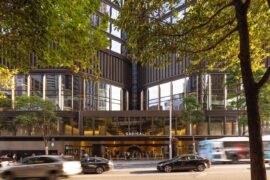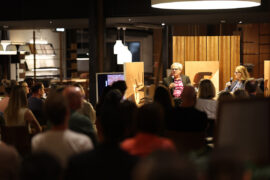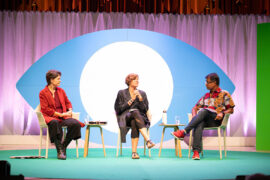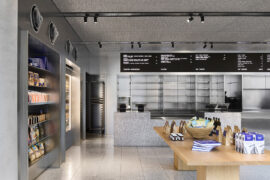Architectus Conrad Gargett’s revitalisation of Africa Hall in Addis Ababa traces lines of historical, cultural and architectural significance.

November 4th, 2024
Africa Hall recalls the heady days of postcolonial independence movements and their complex expression through architectural modernism. Set in Addis Ababa, Ethiopia, the 1961 building was designed by Italian architect, Arturo Mezzèdini as a meeting place for African nation states and headquarters for the United Nations Economic Commission for Africa (ECA). It was a gift to the continent from Emperor Haile Selassie I, and has played host to historically significant events such as the 1963 African Summit Conference toward African Unity, which culminated with the signing of the Charter for the Organisation of African Unity (OAU) by the heads of African States and the establishment of the OAU, the precursor to the African Union (AU).
The recently completed redesign was initiated by the ECA following the building’s 50th anniversary in collaboration with the United Nations Educational, Scientific and Cultural Organisation (UNESCO), the African Union Commission, and the Ethiopian Government. Conrad Gargett was commissioned to lead the revitalisation, working with Ethiopian architects and consultants.

Africa Hall was re-inaugurated on 21st October in the presence of H.E. Dr Abiy Ahmed, Prime Minister of the Federal Democratic Republic of Ethiopia; H.E. António Guterres, Secretary-General of the United Nations; H.E. Mohamed Ould Cheikh El Ghazouani, President of the Islamic Republic of Mauritania and Chair of the African Union for 2024; and H.E. Moussa Faki Mahamat, Chairperson of the African Union Commission.
“We feel incredibly honoured and privileged to have given new life to this highly significant modern heritage building, ensuring it is valued and used by future generations,” says David Gole, Principal at Architectus Conrad Gargett and lead on the project alongside Project Architect, Simon Boundy. “The project presented a significant opportunity to reopen the building to the public and provide an engaging visitor experience through sharing the story of Africa Hall and its important role in shaping modern African history.”

Over and above the obviously significant cultural and historical layers involved, the project has also involved a great deal of design work, from hard-headed structural concerns to the integration of important artworks. Having set out a Conservation Management Strategy, the design team undertook extensive research into Mezzèdini’s original design with a view towards balancing that intent with contemporary additions.
“The renovation was truly holistic and unique in that it encompassed all aspects of the building considered as a total work of art – a gesamtkunstwerk – a composition of integrated elements where architecture, interiors, integrated artworks, furniture and landscape setting were all designed in unison as one,” explains Gole.
Related: Learning from the Global South with Tosin Oshinowo

The restored artworks include the hero 150-square-metre stained-glass piece by internationally renowned Ethiopian artist, Afewerk Tekle, and the 40-metre-long mural by Italian painter, Nenne Sanguineti Poggi. Tekle’s work, made by Studio Atelier Thomas Vitraux in Valence, France, was restored by Emmanuel Thomas, the grandson of the original maker. Under the design guidance of Architectus Conrad Gargett, the original mosaic floor artwork ‘African Fauna’ in the rotunda space, which had previously been removed, was reinstated based on original drawings and photographic evidence. Over 500 bespoke original furniture pieces, custom-designed by Mezzèdimi, have also restored and returned to their original places.
Meanwhile, the building’s exterior has seen significant work too – including, remarkably, 13 million new tiles being fabricated and reinstalled to exactly match the original material, textured profile and modernist colour palette of brown, orange and off-white. Structural updates have then included the remediation of the reinforced concrete, while external envelope restoration has involved replacing the end-of-life façade glazing with contemporary high-performance glazing systems for improved energy efficiency and security. New dome roof sheeting and upgraded rainwater systems also feature.

The overall brief called for a modern conference facility with four key objectives: to conserve the place based on international best practice; to upgrade the building services and technology to enhance ongoing use as a modern conference facility and facilitate new uses; to improve safety and accessibility; and to provide a permanent exhibition to tell the story of the building. Addressing the final point, Architectus Conrad Gargett has created a new museum space, while other additions include a new separate visitor centre, car parking, bus drop-off zone and a ground-floor café where the 1960s interior was reconstructed.
Perhaps the climax of the building arrives in circular form with the Assembly or Plenary Hall. This space has been fully modernised to accommodate today’s African Union through seating reconfiguration, which has increased from a double to a triple horseshoe joinery. Other features now include advanced audio-visual technology, a 13-metre-wide curved LED display for live broadcasts, and remote interpretation facilities, while a delegates’ lounge provides breakout space.
In an era of renewed colonial violence, Global South consciousness and the undermining of UN institutions, the redesign of Africa Hall tells us about the role architecture can play.
Architectus Conrad Gargett
architectus.com.au
Photography
Rory Gardiner





INDESIGN is on instagram
Follow @indesignlive
A searchable and comprehensive guide for specifying leading products and their suppliers
Keep up to date with the latest and greatest from our industry BFF's!

For Aidan Mawhinney, the secret ingredient to Living Edge’s success “comes down to people, product and place.” As the brand celebrates a significant 25-year milestone, it’s that commitment to authentic, sustainable design – and the people behind it all – that continues to anchor its legacy.

Rising above the new Sydney Metro Gadigal Station on Pitt Street, Investa’s Parkline Place is redefining the office property aesthetic.

He’s the Director of Eames Office and an all-round creative polymath – and Eames Demetrios has just been in our region with Living Edge.
The internet never sleeps! Here's the stuff you might have missed

At the World Design Congress in London, a simple idea threaded through two dense days: design is not an island. It moves inside wider systems of economics, policy, finance and ecology.

IF Architecture crafts Baker Bleu Cremorne into a refined, sustainable bakery and café where industrial design meets artisanal warmth.